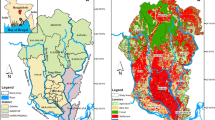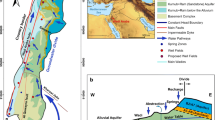Abstract
Management of groundwater resources can be enhanced by using numerical models to improve development strategies. However, the lack of basic data often limits the implementation of these models. The Kharga Oasis in the western desert of Egypt is an arid area that mainly depends on groundwater from the Nubian Sandstone Aquifer System (NSAS), for which the hydrogeological data needed for groundwater simulation are lacking, thereby introducing a problem for model calibration and validation. The Grey Model (GM) was adopted to analyze groundwater flow. This model combines a finite element method (FEM) with a linear regression model to try to obtain the best-fit piezometric-level trends compared to observations. The GM simulation results clearly show that the future water table in the northeastern part of the study area will face a severe drawdown compared with that in the southwestern part and that the hydraulic head difference between these parts will reach 140 m by 2060. Given the uncertainty and limitation of available data, the GM produced more realistic results compared with those obtained from a FEM alone. The GM could be applied to other cases with similar data limitations.
Résumé
Une gestion des ressources en eau souterraines peut être optimisée en utilisant des modèles numériques pour améliorer les stratégies de développement. Toutefois, le manque de données de base limite souvent la mise en œuvre de ces modèles. L’oasis de Kharga dans l’Ouest du désert égyptien est une zone aride qui dépend principalement du système aquifère du Grès Nubien (NSAS), pour lequel les données hydrogéologiques requises pour la simulation de nappe manquent, introduisant par là un problème de calibration et de validation des modèles. Le Modèle de Grey (GM) a été adopté pour analyser le débit de nappe souterraine. Ce modèle combine une méthode par éléments finis (FEM) avec un modèle de régression linéaire pour essayer d’obtenir la meilleure correspondance avec les niveaux piézométriques observés. Les résultats de la simulation GM montrent clairement que la future surface libre de la nappe dans la partie Nord-Est de l’étude va faire face à un sévère étiage comparativement à celle de partie Sud-Ouest et que la différence piézométriques atteindra 140 m vers 2060. Etant donnés l’incertitude et le caractère limité des données disponibles, les résultats produits par le Modèle GM sont plus réalistes que ceux obtenus par une méthode basée sur des éléments finis (FEM) seule. Le Modèle GM pourrait être appliqué à d’autres cas présentant des limitations de données similaires.
Resumen
La gestión de los recursos de agua subterránea puede ser enriquecida usando modelos numéricos para mejorar las estrategias de desarrollo. Sin embargo, la carencia de datos básico a menudo limita la implementación de estos modelos. El Oasis de Kharga en el desierto occidental de Egipto es un área árida que depende principalmente del agua subterránea del Sistema Acuífero de las Areniscas de Nubian (NSAS), para el cual los datos hidrogeológicos necesarios para la simulación del agua subterránea están faltantes, introduciendo por lo tanto un problema para la calibración y validación del modelo. Se adaptó el modelo Grey (GM) para analizar el flujo de agua subterránea. Este modelo combina un método de elementos finitos (FEM) con un modelo de regresión lineal para tratar de obtener el mejor ajuste de las tendencias del nivel piezométrico comparado con las observaciones. Los resultados de la simulación del GM muestran claramente que el futuro del nivel freático en la parte nororiental del área de estudio enfrentará una severa depresión comparado con la de la parte sudoccidental y que las diferencias de carga hidráulica entre estas partes alcanzarán 140 m en 2060. Dada la limitación e incertidumbre de los datos disponibles, el GM produjo resultados más realista comparados con aquellos obtenidos a partir de sólo el FEM. El GM podría ser aplicado a otros casos con similares limitaciones de datos.
Resumo
A gestão dos recursos hídricos subterrâneos pode beneficiar de modelos numéricos para melhorar as estratégias de desenvolvimento. No entanto, a falta de dados de base limita frequentemente a aplicação destes modelos. O Oásis Kharga, no deserto ocidental do Egito, é uma região árida que depende maioritariamente de água subterrânea extraída do Sistema Aquífero do Arenito Núbio (NSAS). A falta de dados hidrogeológicos necessários para a simulação de fluxo deste sistema aquífero introduz um entrave à calibração e validação do modelo. Foi adotado o Modelo Cinza (MC) para analisar o fluxo das águas subterrâneas. Este modelo combina um método de elementos finitos (MEF) com um modelo de regressão linear para tentar obter o melhor ajuste das tendências dos níveis piezométricos em relação às observações. Os resultados da simulação do MC mostram claramente que o nível freático na parte nordeste da área de estudo irá sofrer um rebaixamento severo no futuro, comparativamente com a zona sudoeste, e que a diferença de potencial hidráulico entre os dois sectores chegará aos 140 m em 2060. Dada a incerteza e limitação de dados disponíveis, o MC produziu resultados mais realistas quando comparados com os resultados obtidos unicamente a partir do MEF, podendo ser aplicado a outros casos com restrições de dados semelhantes.















Similar content being viewed by others
References
Abdelrahman A, Watanabe K, Mebruk MN, Takeuch S (2010) Estimating groundwater residence time using multiple regression model based on fluoride dissolution. Environ Earth Sci 60:449–462
Affandi AK, Watanabe K (2007) Daily groundwater level fluctuation forecasting using soft computing technique. Nat Sci 5:1–10
Amarsinghe SR, Watanabe K, Ishiyama K (2011) Study on the selection of unsaturated flow model for the different types of soil and soft rock. Environ Earth Sci 64:1795–1805
Anderson MP, Woessener WW (1992) Applied groundwater modeling-simulation of flow and advective transport. Academic, San Diego, CA
Ball J (1927) Problems of the Libyan Desert. Geogr J 70:21–38, 105–128, 209–224
Brinkmann P, Heinl M (1986) Numerical groundwater model. In: Thorweihe U (ed) Impact of climatic variation on East Saharan groundwater: modeling of large-scale flow regimes. Proc. workshop hydrogeol, 20–22 May 1985, Berlin. SFB 69, Berliner Geowiss Abh A 72: 135–155
Coley DA (1999) An introduction to genetic algorithms for scientists and engineers. World Scientific, Singapor
Ebraheem AM, Riad S, Wycisk P, Seif El Nasr AM (2002) Simulation of impact of present and future groundwater extraction from the non-replenished Nubian Sandstone Aquifer in SW Egypt. Environ Geol 43:188–196
Goldberg DE, Deb K (1991) A comparative analysis of selection schemes used in genetic algorithms. In: Rawlins GJE (ed) Foundations of Genetic Algorithms. Kaufmann, Burlington, MA
Heinl M, Thorweihe U (1993) Groundwater resources and management in SW Egypt. In: Meissner B, Wycisk P (eds) Geopotential and ecology. Catena Suppl 26, Catena, Reiskirchen, Germany, pp 99–121
Hesse K, Hissne A, Kheir O, Schnäcker E, Schneider M, Thorweihe U (1987) Hydrogeological investigations in the Nubian sandstone aquifer system, Eastern Sahara. Berliner Geowiss Abh A75:397–4641
Kehl H, Bornkamm R (1993) Landscape ecology and vegetation units of the Western Desert of Egypt. In: Meissner B, Wycisk P (eds) Geopotential ecology: analysis of a desert region. Catena Suppl 26, Catena, Reiskirchen, Germany, pp 155–178
Khang ND, Watanabe K, Saegusab H (2004) Fracture step structure: geometrical characterization and effects on fluid flow and breakthrough curve. Eng Geol 75:107–127
Knetsch G, Yallouze M (1955) Remarks on the origin of the Egyptian Oasis depressions. Bull Soc Géogr Égypte 28:21–33
Lamoreaux PE, Memon BA, Idris H (1985) Groundwater development, Kharga Oasis, western desert of Egypt: a long-term environment concern. Environ Geol Water Sci 7:129–149
Mitchell M (1999) An introduction to genetic algorithms. Massachusetts Institute of Technology, Cambridge, MA
Mohammed M, Watanabe K, Takeuchi S (2010) Grey model for prediction of pore pressure change. Environ Earth Sci 60:1523–1534
Nash JE, Sutcliffe JV (1970) River flow forecasting through conceptual models, part 1: a discussion of principles. J Hydrolgeol 10:282–290
Nour S (1996) Groundwater potential for irrigation in the east Oweinat area, Western Desert, Egypt. Environ Geol 27:143–154
Pinder GF, Gray WG (1977) Finite element simulation in surface and subsurface hydrology. Academic, New York
Said R (1962) The geology of Egypt. Elsevier, Amsterdam
Said R (1990) Geomorphology. In: Said R (ed) The geology of Egypt. Taylor and Francis, Rotterdam, The Netherlands
Salman AB, Howari FM, El-Sankary MM, Wali AM, Saleh MM (2010) Environmental impact and natural hazards on Kharga Oasis monumental sites, Western Desert of Egypt. J Afr Earth Sci 58:341–353
Sanford KS (1935) Source of water in the northern-western Sudan. Geogr J 85:412–431
Shamseldin AY (1997) Application of a neural network technique to rainfall-runoff modeling. J Hydrol 199:272–294
Shata AA (1982) Hydrogeology of the great Nubian Sandstone basin, Egypt. Q J Eng Geol 15:127–133
Sivaraj R, Ravichandran T (2011) A review of selection methods in genetic algorithm. Int J Eng Technol 3:3792–3797
Sonntag C (1986) A time-dependent groundwater model for the Eastern Sahara. Berliner Geowiss Abh A72:124–134
Spitz K, Moreno J (1996) A practical guide to groundwater and solute transport modeling. Wiley, New York
Thorweihe U, Heinl M (2002) Groundwater resources of the Nubian Aquifer System, NE-Africa. Synthesis, Observatoire du Sahara et du Sahel, Paris
Thorweihe U, Schandelmeier H (1993) Geoscientific research in Northeast Africa. Proc Int Conf Geosci. Balkema, Rotterdam, The Netherlands, 776 pp
Watanabe K (1988) Analysis of three-dimensional groundwater flow in the near-surface layer of a small watershed. J Hydrol 102:287–300
Watanabe K, Kattel S, Takeuchi S, Mahmod WE (2012) Analysis of pore pressure changes due to shafts excavation by using Genetic Algorithm (GA). JSCE 68(1):193–198
Wikipedia (2007–2012) URLs regarding the Kharga, Farafra, Dakhla, and Baris oases. http://en.wikipedia.org/wiki/Kharga. Accessed June 2008; http://en.wikipedia.org/wiki/Farafra. Accessed June 2012; http://en.wikipedia.org/wiki/Dakhla,_Egypt. Accessed January 2007; http://en.wikipedia.org/w/index.php?title=Baris,_Egypt&action=edit&redlink=1. Accessed January 2012
Acknowledgements
The authors would like to acknowledge Eng. Ashraf Zahr El-deen for supporting us with the data required for this research. Special words of gratitude go to Prof. Gamal Abo-zeid for his support and encouragement.
Author information
Authors and Affiliations
Corresponding author
Rights and permissions
About this article
Cite this article
Mahmod, W.E., Watanabe, K. & Zahr-Eldeen, A.A. Analysis of groundwater flow in arid areas with limited hydrogeological data using the Grey Model: a case study of the Nubian Sandstone, Kharga Oasis, Egypt. Hydrogeol J 21, 1021–1034 (2013). https://doi.org/10.1007/s10040-013-0959-2
Received:
Accepted:
Published:
Issue Date:
DOI: https://doi.org/10.1007/s10040-013-0959-2




